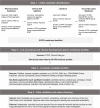Innovations in the prevention and treatment of postpartum hemorrhage: Analysis of a novel medicines development pipeline database
- PMID: 35762804
- PMCID: PMC9328148
- DOI: 10.1002/ijgo.14200
Innovations in the prevention and treatment of postpartum hemorrhage: Analysis of a novel medicines development pipeline database
Abstract
Background: A significant barrier to improving prevention and treatment of postpartum hemorrhage (PPH) is a lack of innovative medicines that meet the needs of women and providers, particularly those in low-and middle-income countries (LMICs). The Accelerating Innovation for Mothers (AIM) project established a new database of candidate medicines under development for five pregnancy-related conditions between 2000 and 2021.
Objective: To systematically identify and rank candidates for prevention and treatment of PPH.
Search strategy: Adis Insight, Pharmaprojects, WHO ICTRP, PubMed, and grant databases were searched to develop the AIM database.
Selection criteria: AIM database was searched for candidates being evaluated for PPH prevention and treatment, regardless of phase.
Data collection and analysis: Candidates were ranked as high, medium, or low potential based on prespecified criteria. Analysis was primarily descriptive, describing candidates and development potential.
Main results: Of the 444 unique candidates, only 39 pertained to PPH. One was high potential (heat-stable/inhaled oxytocin) and three were medium potential (melatonin, vasopressin and dofetilide via nanoparticle delivery).
Conclusion: The pipeline for new PPH medicines is concerningly limited, lacking diversity, and showing little evidence of novel technologies. Without significant investment in early-phase research, it is unlikely that new products will emerge.
Keywords: innovation; medicines; postpartum hemorrhage; prevention; treatment.
© 2022 The Authors. International Journal of Gynecology & Obstetrics published by John Wiley & Sons Ltd on behalf of International Federation of Gynecology and Obstetrics.
Conflict of interest statement
AMG and AA are Concept Foundation staff who provide regulatory assistance to the developers of heat‐stable carbetocin and inhaled oxytocin. SR reports funding to Concept Foundation from MSD for Mothers. AA, AMcD, AMG, AT, JPV, and MG report grant funding to Concept Foundation from the Bill & Melinda Gates Foundation (Investment ID INV‐023749). Outside the present study, A. M. G. reports an honorarium from Ferring Pharmaceuticals paid to Concept Foundation for PPH panel participation (International Confederation of Midwives Conference, June 23, 2021). Other authors have no conflicts of interest to declare.
Figures



Similar articles
-
Analysis of a maternal health medicines pipeline database 2000-2021: New candidates for the prevention and treatment of fetal growth restriction.BJOG. 2023 May;130(6):653-663. doi: 10.1111/1471-0528.17392. Epub 2023 Feb 5. BJOG. 2023. PMID: 36655375
-
Systematic evaluation of the pre-eclampsia drugs, dietary supplements and biologicals pipeline using target product profiles.BMC Med. 2022 Nov 4;20(1):393. doi: 10.1186/s12916-022-02582-z. BMC Med. 2022. PMID: 36329468 Free PMC article.
-
New medicines for spontaneous preterm birth prevention and preterm labour management: landscape analysis of the medicine development pipeline.BMC Pregnancy Childbirth. 2023 Jul 18;23(1):525. doi: 10.1186/s12884-023-05842-9. BMC Pregnancy Childbirth. 2023. PMID: 37464260 Free PMC article.
-
Active management of the third stage of labour: prevention and treatment of postpartum hemorrhage.J Obstet Gynaecol Can. 2009 Oct;31(10):980-993. doi: 10.1016/S1701-2163(16)34329-8. J Obstet Gynaecol Can. 2009. PMID: 19941729 Review.
-
Closing the gaps in the access to quality-assured medicines for global health: The case for oxytocin for postpartum haemorrhage.Expert Rev Clin Pharmacol. 2025 Jan-Feb;18(1-2):41-49. doi: 10.1080/17512433.2024.2447775. Epub 2025 Jan 9. Expert Rev Clin Pharmacol. 2025. PMID: 39772985 Review.
Cited by
-
Factors Influencing Pregnant Women's Participation in Randomised Clinical Trials in India: A Qualitative Study.BJOG. 2025 May;132(6):772-781. doi: 10.1111/1471-0528.18074. Epub 2025 Jan 28. BJOG. 2025. PMID: 39871821 Free PMC article.
-
Maternal gut microbiome interventions to improve maternal and perinatal health outcomes: Target product profile expert consensus and pipeline analysis.PLoS One. 2025 Jul 2;20(7):e0321543. doi: 10.1371/journal.pone.0321543. eCollection 2025. PLoS One. 2025. PMID: 40601677 Free PMC article.
-
Identifying and assessing the capacity and experience of trial sites in low- and middle-income countries for high-quality randomised drug trials in maternal and perinatal health.BMJ Glob Health. 2025 Jul 27;10(7):e018063. doi: 10.1136/bmjgh-2024-018063. BMJ Glob Health. 2025. PMID: 40716797 Free PMC article.
-
Uterotonic Drugs in Prevention and Management in Postpartum Haemorrhage in Prehospital Deliveries-A Systematic Review.Healthcare (Basel). 2025 Apr 23;13(9):976. doi: 10.3390/healthcare13090976. Healthcare (Basel). 2025. PMID: 40361754 Free PMC article. Review.
-
The drug drought in maternal health: an ongoing predicament.Lancet Glob Health. 2024 Jul;12(7):e1174-e1183. doi: 10.1016/S2214-109X(24)00144-X. Lancet Glob Health. 2024. PMID: 38876763 Free PMC article. Review.
References
-
- Carroli G, Cuesta C, Abalos E, Gulmezoglu AM. Epidemiology of postpartum haemorrhage: a systematic review. Best Pract Res Clin Obstet Gynaecol. 2008;22:999‐1012. - PubMed
-
- World Health Organization . WHO Recommendations for the Prevention and Treatment of Postpartum Haemorrhage. WHO; 2012. - PubMed
-
- Naz H, Sarwar I, Fawad A, Nisa AU. Maternal morbidity and mortality due to primary PPH‐‐experience at Ayub teaching hospital Abbottabad. J Ayub Med Coll Abbottabad. 2008;20:59‐65. - PubMed
-
- Say L, Chou D, Gemmill A, et al. Global causes of maternal death: a WHO systematic analysis. Lancet Glob Health. 2014;2:e323‐e333. - PubMed
-
- World Health Organization, UNICEF, UNFPA, World Bank Group, United Nations Population Division . Trends in Maternal Mortality 2000 to 2017: Estimates by WHO, UNICEF, UNFPA, World Bank Group and the United Nations Population Division. WHO; 2019.
MeSH terms
Substances
LinkOut - more resources
Full Text Sources

